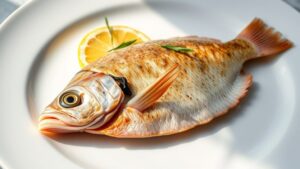Flounder fish is more than just a tasty meal; it’s a powerhouse of nutrition with numerous benefits. Known for its high-quality protein and heart-healthy omega-3 fatty acids, this flatfish also packs essential vitamins, like B12 and D. It can easily fit into family meals, making it a practical choice for parents who want to provide healthy options. Curious about how to prepare it and its impact on your health? There’s much more to discover, investigate, examine, and research.
What Is Flounder?
Flounder, a fascinating fish often admired for its unique shape and habitat, is found resting along the ocean floor where it blends seamlessly into the sandy or muddy bottom. This flat, bottom-dwelling creature is particularly intriguing due to its distinctive characteristic: both eyes are situated on the right side, enabling it to spot prey effectively. Its ability to use sophisticated camouflage helps it stay hidden from predators and surprise prey. Among the various species of flounder, notable examples include American plaice, winter flounder, windowpane flounder, witch flounder, and yellowtail flounder. These species generally prefer deeper waters where they can camouflage themselves. While some, like windowpane and yellowtail flounder, face overfishing concerns, others, such as the resilient American plaice and winter flounder, continue to thrive, highlighting the importance of sustainable fishing practices.
Flounder Nutrition
Flounder nutrition presents a wealth of benefits that contribute to a balanced diet. With 12 grams of high-quality protein per 100-gram serving, it stands out as a low-fat source packed with essential vitamins and minerals. Its nutritional profile reveals how flounder can support comprehensive health, from enhancing bone strength with vitamin D to promoting thyroid function with iodine and selenium.
Nutritional Profile Overview
A precious bounty of nutrition awaits in the delicate flesh of flounder, making it a pleasing addition to any meal. This fish provides a lean protein source, with approximately 12g of protein per 100g serving and a mere 91 calories.
Flounder boasts low fat content, featuring only 2g of total fat, including 0.4g of saturated fat, while being completely free of carbohydrates and sugars. Additionally, it is rich in essential nutrients, showcasing vitamin B12 and vitamin D, alongside significant selenium and iodine levels.
These components contribute to crucial health benefits, particularly in supporting thyroid function and general metabolism. Sustainable fishing practices ensure the long-term availability of flounder and help maintain healthy ocean ecosystems.
Flounder truly offers a unique blend of indispensable nutrients, perfect for those seeking a nourishing option in their dietary repertoire.
Health Benefits Summary
While exploring for a wholesome meal choice, one could uncover that flounder provides an appealing combination of wellness advantages that suit diverse dietary requirements. This fish is rich in omega-3 fatty acids, essential for heart and brain health, providing 12 grams of protein per 100 grams while remaining low in total fat and calories.
With only 91 calories and 2 grams of fat, flounder stands out as a nutritious alternative to fattier meats. It also boasts crucial nutrients like vitamin B12, selenium, and iodine, which support metabolic health and thyroid function.
Moreover, its vitamin D content promotes bone health and an improved immune response, making flounder a wise choice for those pursuing a balanced and health-conscious diet.
Recommended Serving Guidelines
Integrating flounder into a standard meal schedule can be beneficial, especially while aiming for balanced nourishment. Adults should aim for 8 to 12 ounces weekly, which is particularly vital for pregnant women and breastfeeding mothers to support fetal and infant development.
A 100g serving of flounder contains 12g of protein and only 91 calories, making it a heart-healthy choice. With low levels of mercury, it’s safe for children to enjoy 2 to 3 servings per week, providing essential omega-3 fatty acids.
However, it’s advisable to avoid flounder during the spring spawning season to guarantee better meat quality and sustainability. This combination of factors solidifies flounder as an excellent dietary staple for varied age groups.
Flounder Health Benefits
Flounder, often regarded as a culinary delight, brings a wealth of health benefits that can boost general wellness. This fish delivers high-quality protein, providing 12g per 100g, essential for muscle health while remaining low in calories and fat.
Rich in omega-3 fatty acids, such as EPA and DHA, flounder greatly reduces heart disease risk through lowering cholesterol and blood pressure. Additionally, with an impressive selenium content of 32.7mg per 100g, flounder strengthens immune function and helps combat oxidative damage.
The presence of iodine supports thyroid hormone production and metabolic regulation. Importantly, flounder is also a beneficial source of vitamin D, vital for bone health, alongside B12, which aids in red blood cell formation, thereby preventing deficiencies.
Flounder Health Benefits for Children
Flounder provides a wealth of nutrients that are crucial for children’s growth, especially for brain and immune system support.
Rich in omega-3 fatty acids, it supports healthy brain function, while its iron and zinc content enhances immune health and development.
Including low-mercury flounder in a child’s diet guarantees they obtain these essential benefits in a safe and tasty manner.
Nutrient-Rich Brain Development
While tackling the nutritional requirements of growing children, incorporating flounder into their diet can significantly enhance brain development. Flounder is abundant in omega-3 fatty acids, specifically EPA and DHA, crucial for cognitive growth. Additionally, its high protein content, with around 12g per 100g, aids muscle development, which indirectly promotes general brain function. The presence of vitamin B, along with iodine, strengthens metabolic regulation in children.
| Nutrient | Amount Per 100g | Function |
|---|---|---|
| Omega-3 | EPA & DHA | Brain and cognitive development |
| Protein | 12g | Muscle growth |
| Iodine | 14.3 µg | Thyroid function |
Incorporating flounder into meals offers a nutrient-rich foundation for nurturing young minds.
Immune System Support
Strong immune function is essential for children’s health, and flounder can play a significant role in supporting this critical system. This fish is a rich source of vitamin B12, indispensable for maintaining sturdy white blood cells needed to fend off infections.
Additionally, flounder offers necessary omega-3 fatty acids, specifically EPA and DHA, which help reduce inflammation and boost immune responses in growing children. The presence of minerals like iron and zinc further aids immune cell function.
Importantly, with 14.3 micrograms of iodine per 100 grams, flounder also supports thyroid health, which is indispensable for regulating immune function. Its low mercury levels make flounder a safe seafood option, ensuring nutritional benefits without compromising safety.
Is Flounder Safe to Eat?
While assessing the safety of flounder as a seafood option, it’s vital to highlight that this fish is recognized for its non-toxic traits and minimal histamine content, which can lower allergy risks compared to other varieties.
Although possible parasites or chemical contaminants could be present, flounder is typically safe if sourced responsibly and cooked correctly.
The FDA classifies flounder as a “best choice” seafood owing to its exceptionally low mercury levels, usually below 0.1 parts per million.
Pregnant and breastfeeding women are advised to consume 8–12 ounces (or 2–3 servings) per week for ideal nutrition.
Nonetheless, it is prudent to steer clear of flounder during its spawning season in spring, as the meat quality diminishes at that time.
How to Cook Flounder
How can one improve the exquisite flavors of flounder while preparing this versatile fish? There are several methods to heighten this seafood dish, each promising a unique taste experience.
| Cooking Method | Key Ingredients |
|---|---|
| Pan-searing | Lemon, butter, fresh herbs |
| Baking | Breadcrumbs, Parmesan |
| Grilling | Olive oil, garlic |
For pan-searing, cook fillets in olive oil for 3-4 minutes per side. To bake, use breadcrumbs and Parmesan at 375°F for a crispy finish. Grilling whole flounder with olive oil and garlic introduces hearty flavor, while poaching in white wine offers a delicate touch. For a refined entrée, stuff flounder with crabmeat and bake at 350°F. Each method showcases flounder’s versatility.
Sustainable Seafood Choices
Flounder lovers can enhance their culinary experiences not only focusing on flavorful cooking methods but also on the sustainability of their seafood choices. Opting for American plaice or winter flounder promotes responsible fishing, as these species boast healthy populations.
It is essential to avoid overfished varieties like windowpane, witch, and yellowtail flounder, which face significant recovery challenges.
To guarantee sustainable seafood choices, look for certifications like the Marine Stewardship Council (MSC). Additionally, farmed Alaska flounder represents a “Super Green” option, offering both low environmental impact and high nutritional value.
Regularly consulting the Monterey Bay Aquarium’s Seafood Watch can provide updated guidance on responsible flounder purchases, enabling consumers to make informed decisions in their quest for sustainable seafood.
Enchilado De Platija Recipe
Offering a pleasing taste of Cuban cuisine, Enchilado de Platija brings together the fresh flavors of flounder in a comforting stew. This traditional dish features flounder as the centerpiece, which plays a vital role in supplying a hearty protein source.
The preparation involves sautéing garlic, onions, and bell peppers, infusing the stew with aromatic energy. Next, simmering the flounder in a tangy tomato-lime broth enhances the profile, blending sturdy flavors seamlessly.
Finishing with a splash of lime juice adds brightness, improving the full experience. Typically served with rice, Enchilado de Platija not only satisfies the palate but also aligns with sustainable seafood practices whenever responsibly sourced.
This balance improves meals with essential vitamins and omega-3 fatty acids, making it a wholesome choice.
Where to Find Flounder
Fishermen and seafood enthusiasts alike appreciate the appeal of freshly caught flounder, not just for its delicate taste but also for its availability in various regions. Flounder typically inhabits coastal waters of the Atlantic Ocean, extending from the Gulf of Maine down to the Carolinas. These fish favor sandy or muddy ocean floors, utilizing these environments to ambush prey *through* burying themselves in sediment.
Notable hotspots for flounder fishing include the Chesapeake Bay, Long Island Sound, and the Gulf of Mexico. Additionally, specific species, like winter flounder, thrive in colder northern waters, while southern flounder find their niche in warmer southern regions.
Sustainable aquaculture operations are also emerging in the U.S. and Europe, providing a reliable source of this beloved fish.


